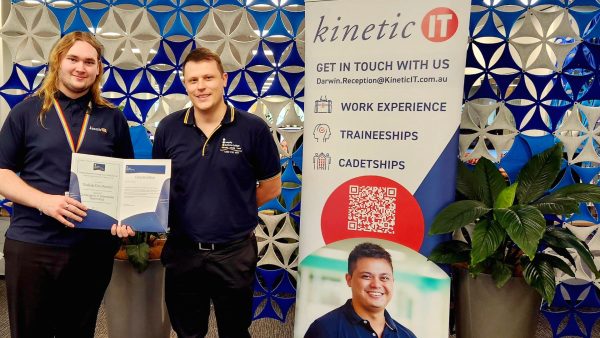Kinetic IT Service Integration and Management (SIAM) specialists Michelle Major-Goldsmith and Simon Dorst spoke about ‘service influence’ in SIAM at Scopism’s Service North event. In this insight, they argue the case for the ‘I’ in SIAM being rebranded to ‘influence’.
Service influence in SIAM
As more organisations recognise the strategic benefits that service integration and management can deliver within multi-vendor environments, there is a growing need for practitioners to hone their ‘service influence’ skills for success.
The need for ‘service influence’ is an observation that stems from our collective professional experiences in the SIAM domain, as well as the growing wealth of knowledge gathered in the annual Global SIAM Survey. In fact, this year’s survey’s results aligned exactly with our observation, with more than 84% of respondents ranking organisational change management, or OCM, as the number one skill required for SIAM success. A key factor of successful OCM is the ability to win friends and influence people, so to speak. The same principle applies to service integration.
Within SIAM models, we see a web of relationships – between the customer, service integrator and service providers, and even greater relationship links within each of role or function. These stakeholders must all work together to co-create value, so it’s essential they build and manage relationships that support collaboration and focus on achieving service outcomes, while optimising costs and mitigating risks.
This brings us to ‘influence’, which can be defined as the power to sway people or decision-making. It involves the ability to persuade, convince, inspire, or motivate others to adopt a particular course of action, viewpoint, or way of thinking. Influence can be exerted in various forms such as through communication, role modelling, or using incentives and rewards. Influence is a crucial aspect of human interaction – where two or more people work together, one has influence over the other.

RELATED CONTENT: 9 surprising insights from the service integration and management community
Influence within a SIAM model
Service providers in your multi-provider ecosystem are the ones that perform or deliver services. That doesn’t mean they’re all the same, as each has their own expertise, experience, background, culture, and values. But, somehow, they all must work together to achieve an outcome.
Any service provider may influence the other providers they work with, which can promote collaboration and integration between them. This influence occurs through setting an example, initiating open communication, focusing on improvement or overcoming an issue (which isn’t about who’s to blame). This brings us to the Service Integrator, who is held responsible for the overall performance of the team.
To an extent, there is a hierarchical relationship which means the service providers do (or should) listen to the Service Integrator – but not all of them feel they must. Perhaps internal service providers find that an external integrator should not tell them what to do, or key providers feel they are indispensable (and can do what they want). The command-structure can partially be enforced by the customer organisation. They can empower the Service Integrator, delegate authority and position them as ‘the voice of the customer’. This should be formalised in contracts and agreements with all service providers. However, authoritative leadership only goes so far.
For an effective Service Integrator to manage the end-to-end performance of the SIAM model, they need to rely on their ability to influence behaviours and activities. Much of this is an extension of what we’ve already mentioned in terms of setting an example, building trust, and having open communication. The Service Integrator plays a more important and more responsible role in this, as they are expected to create and maintain the ‘one team’ culture.
But the Service Integrator also has a relationship with the customer organisation. The customer is the party making all the major decisions, they hold contracts with the service providers and pay for their services. They also set the policy, standards and guidelines that bind both the service providers and the Service Integrator.
The Service Integrator has no hierarchical control of this, but those decisions, as well as governance, reporting and the general tone of the SIAM environment, can make all the difference in not only the service providers listening to the Service Integrator, but even the plain ability of the integrator to do their job. Thus, the Service Integrator needs to influence the customer and manage up. At the end of the day, this is all in the best interest of the customer achieving their strategic objectives. Service integrators need to bring their experience and expertise to bear to become a trusted advisor and shape the service integration and management model to be efficient, effective and successful.

RELATED CONTENT: Navigating VUCA in service management
Service influence: Putting the ‘I’ in SIAM
We can all see that we are past the days of endlessly documenting processes, contracts, reporting frameworks or anything that creates the illusion that we can control it all, define it all and manage it all. The modern complexity of the VUCA world means that we are dependent on the performance of the individuals in our teams, or the service providers in our environments. This requires relationships beyond the hierarchical, contractual, predefined and documented activities but instead a level of collaboration.
This is where influence comes in. It’s about helping the others to do their work better, or influencing them to change their ways to make work easier while also benefitting the common outcomes. The whole is greater than the sum of the parts!
This means creating and fostering a culture where achievement of activities over and above the defined responsibilities of a contract are possible and even encouraged. Organisationally this can be addressed through organisational change management, but culture plays an enabling role as culture exists in all environments – within a team, department, function, or even a meeting. We all contribute to it.
So, let’s see ‘service influence’ as perhaps not so much the new way, but definitely as an essential ingredient in integrating individual service delivery into potential, better end-to-end outcomes.
Kinetic IT has sponsored the 2023 Global SIAM Survey, set to be released late November. Visit our website for details.














